|

by Adam Entous
March 29, 2025
from
TheNewYorkTimes Website
Article also
HERE and
HERE
|
Oleksandr Chubko
and Julie Tate contributed research.
Produced by Gray
Beltran, Kenan Davis and Rumsey Taylor.
Maps by Leanne
Abraham.
Additional
production by William B. Davis. |
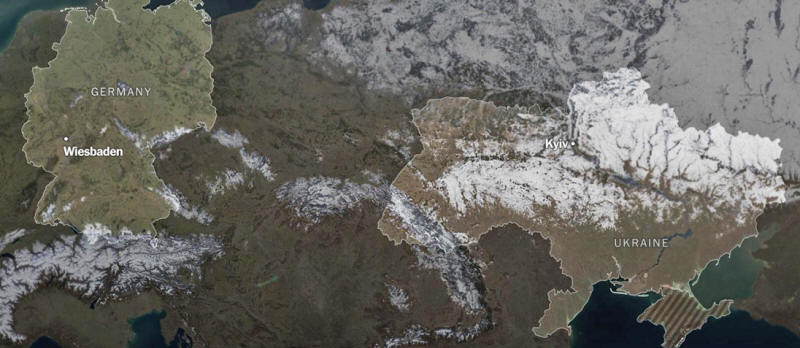
Map pans and
highlights Germany, with the city of Wiesbaden labeled,
and highlights
Ukraine and labels the city of Kyiv.
This is the untold story
of America's hidden role
in Ukrainian military
operations against Russia's invading armies.
Adam Entous conducted more than
300 interviews
over more than a year
with government, military and
intelligence officials in
Ukraine, the United States,
Britain, Germany, Poland,
Belgium, Latvia, Lithuania,
Estonia and Turkey...
On a spring morning two months after Vladimir Putin's
"invading" armies marched into Ukraine, a convoy of unmarked cars
slid up to a Kyiv street corner and collected two middle-aged men in
civilian clothes.
Leaving the city, the convoy - manned by British commandos, out of
uniform but heavily armed - traveled 400 miles west to the Polish
border. The crossing was seamless, on diplomatic passports.
Farther on, they came to the Rzeszów-Jasionka
Airport, where an idling C-130 cargo plane waited.
The passengers were top Ukrainian generals.
Their destination was Clay Kaserne, the
headquarters of U.S. Army Europe and Africa in Wiesbaden,
Germany.
Their mission was to help forge what would
become one of the most closely guarded secrets of the war in
Ukraine.
One of the men, Lt. Gen. Mykhaylo Zabrodskyi,
remembers being led up a flight of stairs to a walkway overlooking
the cavernous main hall of the garrison's Tony Bass Auditorium.
Before the war, it had been a gym, used for
all-hands meetings, Army band performances and Cub Scout pinewood
derbies. Now General Zabrodskyi peered down on officers from
coalition nations, in a warren of makeshift cubicles, organizing the
first Western shipments to Ukraine of M777 artillery batteries and
155-millimeter shells.
Then he was ushered into the office of Lt. Gen. Christopher T.
Donahue, commander of the 18th Airborne Corps, who
proposed a partnership.
Its evolution and inner workings visible to only a small circle of
American and allied officials, that partnership of intelligence,
strategy, planning and technology would become the secret weapon in
what the Biden administration framed as its effort to both rescue
Ukraine and protect the threatened post-World War II order.
Today that order - along with Ukraine's defense of its land -
teeters on a knife edge, as President Trump seeks
rapprochement with Mr. Putin and vows to bring the war to a
close.
For the Ukrainians, the auguries are not
encouraging. In the great-power contest for security and influence
after the Soviet Union's collapse, a newly independent Ukraine
became the nation in the middle, its Westward lean increasingly
feared by Moscow.
Now, with negotiations beginning, the American
president has baselessly blamed the Ukrainians for starting the war,
pressured them to forfeit much of their mineral wealth and asked the
Ukrainians to agree to a cease-fire without a promise of concrete
American security guarantees - a peace with no certainty of
continued peace.
Mr. Trump has already begun to wind down elements of the partnership
sealed in Wiesbaden that day in the spring of 2022.
Yet to trace its history is to better understand
how the Ukrainians were able to survive across three long years of
war, in the face of a far larger, far more powerful enemy. It is
also to see, through a secret keyhole, how the war came to today's
precarious place.
With remarkable transparency, the Pentagon has offered a public
inventory of the $66.5 billion array of weaponry supplied to Ukraine
- including, at last count,
more than a half-billion rounds of small-arms
ammunition and grenades, 10,000 Javelin antiarmor weapons, 3,000
Stinger antiaircraft systems, 272 howitzers, 76 tanks, 40 High
Mobility Artillery Rocket Systems, 20 Mi-17 helicopters and
three Patriot air defense batteries.
But a New York Times investigation reveals
that America was woven into the war far more intimately and broadly
than previously understood.
At critical moments, the partnership was the
backbone of Ukrainian military operations that, by U.S. counts, have
killed or wounded more than 700,000 Russian soldiers. (Ukraine has
put its casualty toll at 435,000.)
Side by side in Wiesbaden's mission command
center, American and Ukrainian officers planned Kyiv's
counteroffensives.
A vast American intelligence-collection effort
both guided big-picture battle strategy and funneled precise
targeting information down to Ukrainian soldiers in the field.
One European intelligence chief recalled being taken aback to learn
how deeply enmeshed his NATO counterparts had become in Ukrainian
operations.
"They are part of the kill chain now," he
said.
The partnership's guiding idea was that this
close cooperation might allow the Ukrainians to accomplish the
unlikeliest of feats - to deliver the invading Russians a crushing
blow.
And in strike after successful strike in the
first chapters of the war - enabled by Ukrainian bravery and
dexterity but also Russian incompetence - that underdog ambition
increasingly seemed within reach.
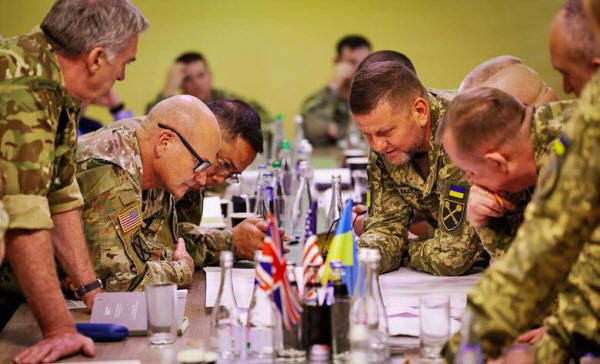
Ukrainian, American
and British military leaders
during a meeting in
Ukraine in August 2023.
Valerii Zaluzhnyi
An early proof of concept was a campaign against one of Russia's
most-feared battle groups, the 58th Combined Arms Army.
In mid-2022, using American intelligence and
targeting information, the Ukrainians unleashed a rocket barrage at
the headquarters of the 58th in the Kherson region,
killing generals and staff officers inside.
Again and again, the group set up at another
location; each time, the Americans found it and the Ukrainians
destroyed it.
Farther south, the partners set their sights on the Crimean port of
Sevastopol, where the Russian Black Sea Fleet loaded missiles
destined for Ukrainian targets onto warships and submarines.
At the height of Ukraine's 2022 counteroffensive,
a predawn swarm of maritime drones, with support from the Central
Intelligence Agency, attacked the port, damaging several warships
and prompting the Russians to begin pulling them back.
But ultimately the partnership strained - and the arc of the war
shifted - amid rivalries, resentments and diverging imperatives and
agendas.
The Ukrainians sometimes saw the Americans as overbearing and
controlling - the prototypical patronizing Americans. The Americans
sometimes couldn't understand why the Ukrainians didn't simply
accept good advice.
Where the Americans focused on measured, achievable objectives, they
saw the Ukrainians as constantly grasping for the big win, the
bright, shining prize. The Ukrainians, for their part, often saw the
Americans as holding them back. The Ukrainians aimed to win the war
outright.
Even as they shared that hope, the Americans
wanted to make sure the Ukrainians didn't lose it.
As the Ukrainians won greater autonomy in the partnership, they
increasingly kept their intentions secret. They were perennially
angered that the Americans couldn't, or wouldn't, give them all of
the weapons and other equipment they wanted.
The Americans, in turn, were angered by what they
saw as the Ukrainians' unreasonable demands, and by their reluctance
to take politically risky steps to bolster their vastly outnumbered
forces.
On a tactical level, the partnership yielded triumph upon triumph.
Yet at arguably the pivotal moment of the war -
in mid-2023, as the Ukrainians mounted a counteroffensive to build
victorious momentum after the first year's successes - the strategy
devised in Wiesbaden fell victim to the fractious internal politics
of Ukraine:
The president, Volodymyr Zelensky, versus
his military chief (and potential electoral rival), and the military
chief versus his headstrong subordinate commander.
When Mr. Zelensky sided with the subordinate, the
Ukrainians poured vast complements of men and resources into a
finally futile campaign to recapture the devastated city of Bakhmut.
Within months, the entire counteroffensive ended
in stillborn failure.
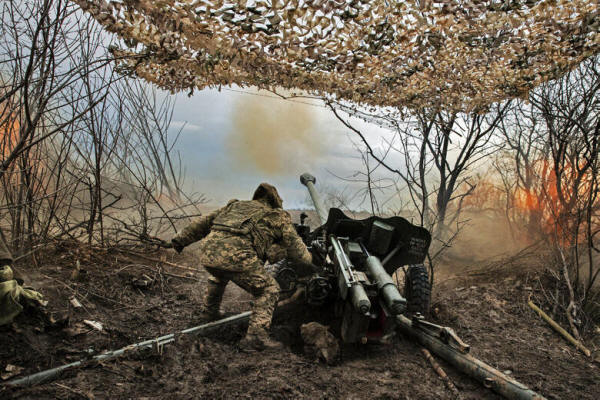
A Ukrainian soldier
fired at
Russian positions near Bakhmut.
Tyler Hicks/The New York Times
The partnership operated in the shadow of deepest geopolitical fear
- that Mr. Putin might see it as breaching a red line of military
engagement and make good on his often-brandished nuclear threats.
The story of the partnership shows
how close the Americans and their allies sometimes came to that red
line, how increasingly dire events forced them - some said too
slowly - to advance it to more perilous ground and how they
carefully devised protocols to remain on the safe side of it.
Time and again, the Biden administration authorized clandestine
operations it had previously prohibited.
American military advisers were dispatched to
Kyiv and later allowed to travel closer to the fighting. Military
and CIA officers in Wiesbaden helped plan and support a campaign of
Ukrainian strikes in Russian-annexed Crimea.
Finally, the military and then the CIA received
the green light to enable pinpoint strikes deep inside Russia
itself.
In some ways, Ukraine was, on a wider canvas, a rematch in a long
history of U.S.-Russia proxy wars:
Vietnam in the 1960s, Afghanistan in the
1980s, Syria three decades later.
It was also a grand experiment in war fighting,
one that would not only help the Ukrainians but reward the Americans
with lessons for any future war.
During the wars against the Taliban and Al Qaeda in Afghanistan and
against the Islamic State in Iraq and Syria, American forces
conducted their own ground operations and supported those of their
local partners.
In Ukraine, by contrast, the U.S. military wasn't
allowed to deploy any of its own soldiers on the battlefield and
would have to help remotely.
Would the precision targeting honed against
terrorist groups be effective in a conflict with one of the most
powerful militaries in the world?
Would Ukrainian artillery men fire their
howitzers without hesitation at coordinates sent by American
officers in a headquarters 1,300 miles away?
Would Ukrainian commanders, based on
intelligence relayed by a disembodied American voice pleading,
"There's nobody there - go," order infantrymen to enter a
village behind enemy lines?
The answers to those questions - in truth, the
partnership's entire trajectory - would hinge on how well American
and Ukrainian officers would trust one another.
"I will never lie to you. If you lie to me,
we're done," General Zabrodskyi recalled General Donahue telling
him at their first meeting.
"I feel the exact same way," the Ukrainian
replied.
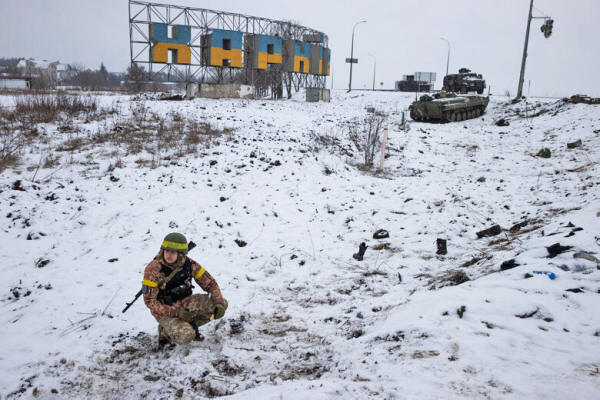
A Ukrainian soldier
keeps watch in
Kharkiv on Feb. 25, 2022,
the day after
Russia "invaded" Ukraine.
Tyler Hicks/The New York Times
Part 1
February–May 2022
Building Trust - and a Killing Machine
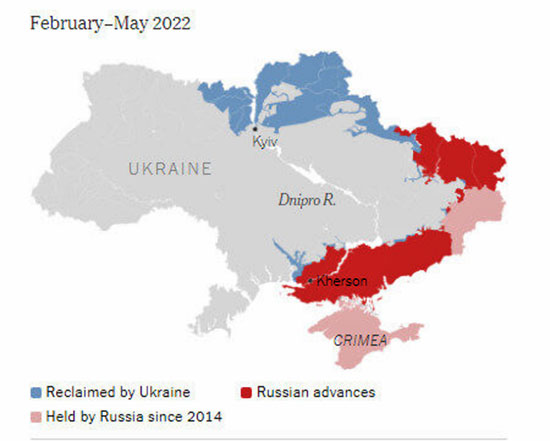
In mid-April 2022, about two weeks before the Wiesbaden meeting,
American and Ukrainian naval officers were on a routine
intelligence-sharing call when something unexpected popped up on
their radar screens.
According to a former senior U.S. military
officer,
"The Americans go: 'Oh, that's the Moskva!'
The Ukrainians go: 'Oh my God. Thanks a lot. Bye'."
The Moskva was the flagship of Russia's
Black Sea Fleet.
The Ukrainians sank it...
Over more than a year of reporting, Adam Entous conducted
more than 300 interviews with current and former policymakers,
Pentagon officials, intelligence officials and military officers in
Ukraine, the United States, Britain and a number of other European
countries.
While some agreed to speak on the record, most
requested that their names not be used in order to discuss sensitive
military and intelligence operations.
The sinking was a signal triumph - a display of Ukrainian skill and
Russian ineptitude. But the episode also reflected the disjointed
state of the Ukrainian-American relationship in the first weeks of
the war.
For the Americans, there was anger, because the Ukrainians hadn't
given so much as a heads-up; surprise, that Ukraine possessed
missiles capable of reaching the ship; and panic, because the Biden
administration hadn't intended to enable the Ukrainians to attack
such a potent symbol of Russian power.
The Ukrainians, for their part, were coming from their own place of
deep-rooted skepticism.
Their war, as they saw it, had started in 2014, when Mr. Putin
seized Crimea and fomented separatist rebellions in eastern Ukraine.
President Barack Obama had condemned the seizure and imposed
sanctions on Russia.
But fearful that American involvement could
provoke a full-scale invasion, he had authorized only strictly
limited intelligence sharing and rejected calls for defensive
weapons.
"Blankets and night-vision goggles are
important, but one cannot win a war with blankets," Ukraine's
president at the time, Petro O. Poroshenko, complained.
Eventually Mr. Obama somewhat relaxed those
intelligence strictures, and Mr. Trump, in his first term,
relaxed them further and supplied the Ukrainians with their first
antitank Javelins.
Then, in the portentous days before Russia's full-scale invasion on
Feb. 24, 2022, the Biden administration had closed the Kyiv embassy
and pulled all military personnel from the country. (A small team of
CIA officers was allowed to stay.)
As the Ukrainians saw it, a senior U.S. military
officer said,
"We told them, 'The Russians are coming - see
ya'."
When American generals offered assistance after
the invasion, they ran into a wall of mistrust.
"We're fighting the Russians. You're not. Why
should we listen to you?" Ukraine's ground forces commander,
Col. Gen. Oleksandr Syrsky, told the Americans the first
time they met.
General Syrsky quickly came around:
The Americans could provide the kind of
battlefield intelligence his people never could.
In those early days, this meant that General
Donahue and a few aides, with little more than their phones, passed
information about Russian troop movements to General Syrsky and his
staff.
Yet even that ad hoc arrangement touched a raw
nerve of rivalry within Ukraine's military, between General Syrsky
and his boss, the armed forces commander, Gen. Valery Zaluzhny.
To Zaluzhny loyalists, General Syrsky was already
using the relationship to build advantage.
Further complicating matters was General Zaluzhny's testy
relationship with the his American counterpart, Gen. Mark A.
Milley, chairman of the Joint Chiefs of Staff.
In phone conversations, General Milley might second-guess the
Ukrainians' equipment requests. He might dispense battlefield advice
based on satellite intelligence on the screen in his Pentagon
office.
Next would come an awkward silence, before
General Zaluzhny cut the conversation short. Sometimes he simply
ignored the American's calls.
To keep them talking, the Pentagon initiated an elaborate telephone
tree: A Milley aide would call Maj. Gen. David S. Baldwin, commander
of the California National Guard, who would ring a wealthy Los
Angeles blimp maker named Igor Pasternak, who had grown up in Lviv
with Oleksii Reznikov, then Ukraine's defense minister.
Mr. Reznikov would track down General Zaluzhny
and tell him, according to General Baldwin,
"I know you're mad at Milley, but you have to
call him."
Ragtag alliance coalesced into partnership in the
quick cascade of events.
In March, their assault on Kyiv stalling, the Russians reoriented
their ambitions, and their war plan, surging additional forces east
and south - a logistical feat the Americans thought would take
months. It took two and a half weeks.
Unless the coalition reoriented its own ambitions, General
Donahue and the commander of U.S. Army Europe and Africa, Gen.
Christopher G. Cavoli, concluded, the hopelessly outmanned
and outgunned Ukrainians would lose the war.
The coalition, in other words, would have to
start providing heavy offensive weapons - M777 artillery batteries
and shells.
The Biden administration had previously arranged emergency
shipments of antiaircraft and antitank weapons. The M777s were
something else entirely - the first big leap into supporting a major
ground war.
The defense secretary, Lloyd J. Austin III, and General
Milley had put the 18th Airborne in charge of delivering
weapons and advising the Ukrainians on how to use them.
When President Joseph R. Biden Jr. signed
on to the M777s, the Tony Bass Auditorium became a full-fledged
headquarters.
A Polish general became General Donahue's deputy. A British general
would manage the logistics hub on the former basketball court. A
Canadian would oversee training.
The auditorium basement became what is known as a fusion center,
producing intelligence about Russian battlefield positions,
movements and intentions.
There, according to intelligence officials,
officers from the Central Intelligence Agency, the National Security
Agency, the Defense Intelligence Agency and the National
Geospatial-Intelligence Agency were joined by coalition intelligence
officers.
The 18th Airborne is known as Dragon Corps:
the new operation would be Task Force Dragon.
All that was needed to bring the pieces together
was the reluctant Ukrainian top command.
At an international conference on April 26 at Ramstein Air Base in
Germany, General Milley introduced Mr. Reznikov and a Zaluzhny
deputy to Generals Cavoli and Donahue.
"These are your guys right here," General
Milley told them, adding: "You've got to work with them. They're
going to help you."
Bonds of trust were being forged. Mr. Reznikov
agreed to talk to General Zaluzhny.
Back in Kyiv,
"we organized the composition of a
delegation" to Wiesbaden, Mr. Reznikov said.
"And so it began."
At the heart of the partnership were two generals
- the Ukrainian, Zabrodskyi, and the American, Donahue.
General Zabrodskyi would be Wiesbaden's chief Ukrainian contact,
although in an unofficial capacity, as he was serving in parliament.
In every other way, he was a natural.
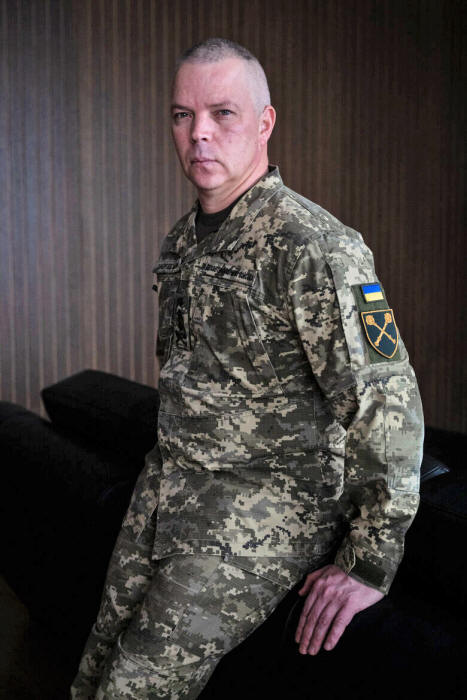
Lt. Gen. Mykhaylo Zabrodskyi,
a key Ukrainian
figure
in the
Wiesbaden partnership.
Nicole Tung for The New York Times
Like many of his contemporaries in the Ukrainian military, General
Zabrodskyi knew the enemy well.
In the 1990s, he had attended military
academy in St. Petersburg and served for five years in the
Russian Army.
He also knew the Americans:
From 2005 to 2006, he had studied at the Army
Command and General Staff College at Fort Leavenworth, Kan.
Eight years later, General Zabrodskyi led a
perilous mission behind lines of Russian-backed forces in eastern
Ukraine, modeled in part on one he had studied at Fort Leavenworth -
the Confederate general J.E.B. Stuart's famous reconnaissance
mission around Gen. George B. McClellan's Army of the
Potomac.
This brought him to the attention of influential
people at the Pentagon; the general, they sensed, was the kind of
leader they could work with.
General Zabrodskyi remembers that first day in Wiesbaden:
"My mission was to find out:
Who is this General Donahue? What is his
authority? How much can he do for us?"
General Donahue was a star in the clandestine
world of special forces.
Alongside CIA kill teams and local partners, he
had hunted terrorist chiefs in the shadows of Iraq, Syria, Libya and
Afghanistan. As leader of the elite Delta Force, he had helped build
a partnership with Kurdish fighters to battle the Islamic State in
Syria.
General Cavoli once compared him to "a comic book
action hero."
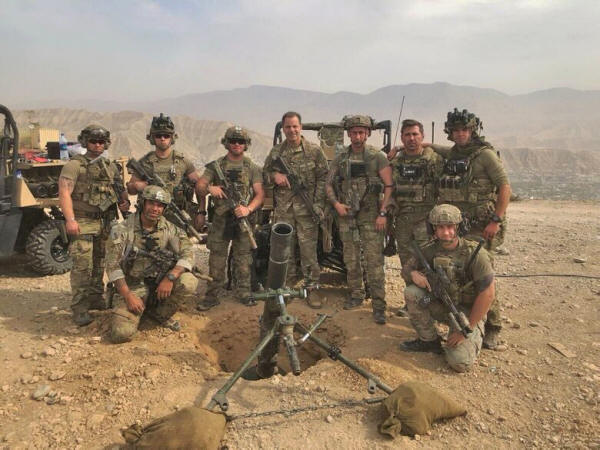
Lt. Gen. Christopher T. Donahue, center, no helmet,
in Afghanistan circa
2020.
Now he showed General Zabrodskyi and his travel companion, Maj. Gen.
Oleksandr Kyrylenko, a map of the besieged east and south of
their country, Russian forces dwarfing theirs.
Invoking their "Glory to Ukraine" battle cry, he
laid down the challenge:
"You can 'Slava Ukraini' all you want with
other people. I don't care how brave you are. Look at the
numbers."
He then walked them through a plan to win a
battlefield advantage by fall, General Zabrodskyi recalled.
The first stage was underway - training Ukrainian artillery men on
their new M777s. Task Force Dragon would then help them use the
weapons to halt the Russian advance. Then the Ukrainians would need
to mount a counteroffensive.
That evening, General Zabrodskyi wrote to his superiors in Kyiv.
"You know, a lot of countries wanted to
support Ukraine," he recalled.
But "somebody needed to be the coordinator,
to organize everything, to solve the current problems and figure
out what we need in the future. I said to the commander in
chief, 'We have found our partner'."
Soon the Ukrainians, nearly 20 in all -
intelligence officers, operational planners, communications and
fire-control specialists - began arriving in Wiesbaden.
Every morning, officers recalled, the Ukrainians
and Americans gathered to survey Russian weapons systems and ground
forces and determine the ripest, highest-value targets. The priority
lists were then handed over to the intelligence fusion center, where
officers analyzed streams of data to pinpoint the targets'
locations.
Inside the U.S. European Command, this process gave rise to a fine
but fraught linguistic debate:
Given the delicacy of the mission, was it
unduly provocative to call targets "targets"?
Some officers thought "targets" was
appropriate.
Others called them "intel tippers," because
the Russians were often moving and the information would need
verification on the ground.
The debate was settled by Maj. Gen. Timothy D.
Brown, European Command's intelligence chief:
The locations of Russian forces would be
"points of interest."
Intelligence on airborne threats would be "tracks
of interest."
"If you ever get asked the question, 'Did you
pass a target to the Ukrainians?' you can legitimately not be
lying when you say, 'No, I did not,'" one U.S. official
explained.
Each point of interest would have to adhere to
intelligence-sharing rules crafted to blunt the risk of Russian
retaliation against NATO partners.
There would be no points of interest on Russian soil. If Ukrainian
commanders wanted to strike within Russia, General Zabrodskyi
explained, they would have to use their own intelligence and
domestically produced weapons.
"Our message to the Russians was, 'This war
should be fought inside Ukraine'," a senior U.S. official said.
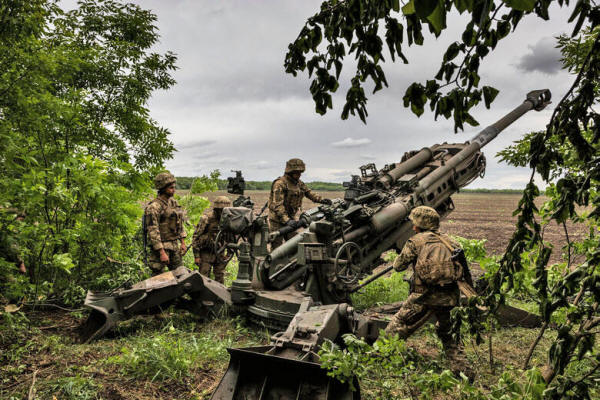
Ukrainian soldiers preparing to
fire
an M777
howitzer at Russian forces in the Donetsk region.
Ivor Prickett for The New York Times
The White House also prohibited sharing intelligence on the
locations of "strategic" Russian leaders, like the armed forces
chief, Gen. Valery Gerasimov.
"Imagine how that would be for us if we knew
that the Russians helped some other country assassinate our
chairman," another senior U.S. official said.
"Like, we'd go to war."
Similarly, Task Force Dragon couldn't
share intelligence that identified the locations of individual
Russians.
The way the system worked, Task Force Dragon would tell the
Ukrainians where Russians were positioned. But to protect
intelligence sources and methods from Russian spies, it would not
say how it knew what it knew.
All the Ukrainians would see on a secure cloud
were chains of coordinates, divided into baskets - Priority 1,
Priority 2 and so on.
As General Zabrodskyi remembers it, when the
Ukrainians asked why they should trust the intelligence, General
Donahue would say:
"Don't worry about how we found out. Just
trust that when you shoot, it will hit it, and you'll like the
results, and if you don't like the results, tell us, we'll make
it better."
The system went live in May.
The inaugural target would be a radar-equipped
armored vehicle known as a Zoopark, which the Russians could use to
find weapons systems like the Ukrainians' M777s. The fusion center
found a Zoopark near Russian-occupied Donetsk, in Ukraine's east.
The Ukrainians would set a trap: First, they would fire toward
Russian lines. When the Russians turned on the Zoopark to trace the
incoming fire, the fusion center would pinpoint the Zoopark's
coordinates in preparation for the strike.
On the appointed day, General Zabrodskyi recounted, General Donahue
called the battalion commander with a pep talk:
"You feel good?" he asked. "I feel real
good," the Ukrainian responded.
General Donahue then checked the satellite
imagery to make sure the target and M777 were properly positioned.
Only then did the artilleryman open fire, destroying the Zoopark.
"Everybody went, 'We can do this!'," a U.S.
official recalled.
But a critical question remained:
Having done this against a single, stationary
target, could the partners deploy this system against multiple
targets in a major kinetic battle?
That would be the battle underway north of
Donetsk, in Sievierodonetsk, where the Russians were hoping to mount
a pontoon-bridge river crossing and then encircle and capture the
city.
General Zabrodskyi called it "a hell of a
target."
The engagement that followed was widely reported as an early and
important Ukrainian victory. The pontoon bridges became death traps;
at least 400 Russians were killed, by Ukrainian estimates.
Unspoken was that the Americans had supplied the
points of interest that helped thwart the Russian assault.
In these first months, the fighting was largely concentrated in
Ukraine's east. But U.S. intelligence was also tracking Russian
movements in the south, especially a large troop buildup near the
major city of Kherson.
Soon several M777 crews were redeployed, and Task
Force Dragon started feeding points of interest to strike Russian
positions there.
With practice, Task Force Dragon produced points of interest faster,
and the Ukrainians shot at them faster.
The more they demonstrated their effectiveness
using M777s and similar systems, the more the coalition sent new
ones - which Wiesbaden supplied with ever more points of interest.
"You know when we started to believe?"
General Zabrodskyi recalled.
"When Donahue said, 'This is a list of
positions.' We checked the list and we said, 'These 100
positions are good, but we need the other 50.' And they sent the
other 50."
The M777s became workhorses of the Ukrainian
army.
But because they generally couldn't launch their
155-millimeter shells more than 15 miles, they were no match for the
Russians' vast superiority in manpower and equipment.
To give the Ukrainians compensatory advantages of precision, speed
and range, Generals Cavoli and Donahue soon proposed a far bigger
leap - providing High Mobility Artillery Rocket Systems, known as
HIMARS, which used satellite-guided rockets to execute strikes up to
50 miles away.
The ensuing debate reflected the Americans' evolving thinking.
Pentagon officials were resistant, loath to deplete the Army's
limited HIMARS stocks. But in May, General Cavoli visited Washington
and made the case that ultimately won them over.
Celeste Wallander, then the assistant defense secretary for
international security affairs, recalled,
"Milley would always say, 'You've got a
little Russian army fighting a big Russian army, and they're
fighting the same way, and the Ukrainians will never win'."
General Cavoli's argument, she said, was that,
"with HIMARS, they can fight like we can, and
that's how they will start to beat the Russians."
At the White House, Mr. Biden and his
advisers weighed that argument against fears that pushing the
Russians would only lead Mr. Putin to panic and widen the
war.
When the generals requested HIMARS, one official
recalled, the moment felt like,
"standing on that line, wondering, if you
take a step forward, is World War III going to break out?"
And when the White House took that step forward,
the official said, Task Force Dragon was becoming,
"the entire back office of the war."
Wiesbaden would oversee each HIMARS strike.
General Donahue and his aides would review the
Ukrainians' target lists and advise them on positioning their
launchers and timing their strikes. The Ukrainians were supposed to
only use coordinates the Americans provided.
To fire a warhead, HIMARS operators needed a
special electronic key card, which the Americans could deactivate
anytime.
HIMARS strikes that resulted in 100 or more Russian dead or wounded
came almost weekly. Russian forces were left dazed and confused.
Their morale plummeted, and with it their will to fight.
And as the HIMARS arsenal grew from eight to 38
and the Ukrainian strikers became more proficient, an American
official said, the toll rose as much as fivefold.
"We became a small part, maybe not the best
part, but a small part, of your system," General Zabrodskyi
explained, adding, "Most states did this over a period of 10
years, 20 years, 30 years. But we were forced to do it in a
matter of weeks."
Together the partners were honing a killing
machine.
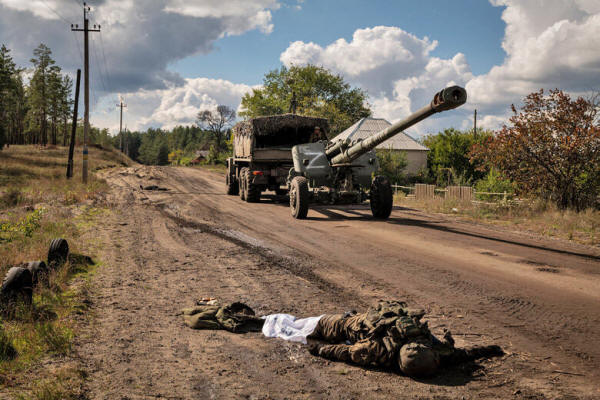
Russian forces collapsed in the
Oskil river valley,
abandoning
their equipment as they fled.
Nicole Tung for The New York Times
Part 2
June-November 2022
'When You Defeat Russia, We Will Make You Blue
for Good'
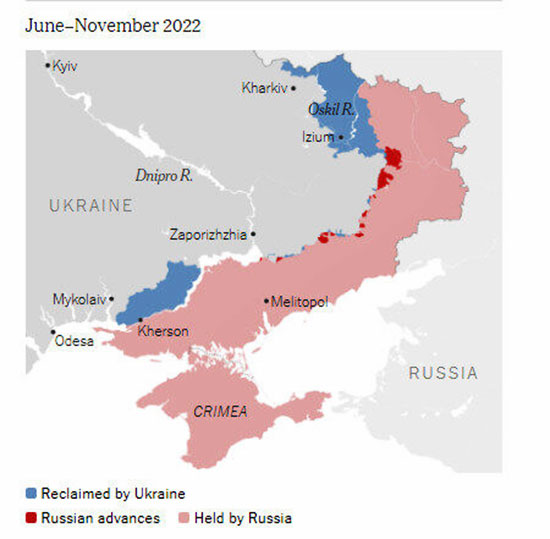
At their first meeting, General Donahue had shown General
Zabrodskyi a color-coded map of the region, with American and
NATO
forces in blue, Russian forces in red and Ukrainian forces in green.
"Why are we green?" General Zabrodskyi asked.
"We should be blue."
In early June, as they met to war-game Ukraine's
counteroffensive, sitting side by side in front of tabletop
battlefield maps, General Zabrodskyi saw that the small blocks
marking Ukrainian positions had become blue - a symbolic stroke to
strengthen the bond of common purpose.
"When you defeat Russia," General Donahue
told the Ukrainians, "we will make you blue for good."
It was three months since the invasion, and the
maps told this story of the war:
In the south, the Ukrainians had blocked the Russian advance at the
Black Sea shipbuilding center of Mykolaiv. But the Russians
controlled Kherson, and a corps roughly 25,000 soldiers strong
occupied land on the west bank of the Dnipro River.
In the east, the Russians had been stopped at
Izium. But they held land between there and the border, including
the strategically important Oskil river valley.
The Russians' strategy had morphed from decapitation - the futile
assault on Kyiv - to slow strangulation. The Ukrainians needed to go
on the offensive.
Their top commander, General Zaluzhny, along with the British,
favored the most ambitious option - from near Zaporizhzhia, in the
southeast, down toward occupied Melitopol.
This maneuver, they believed, would sever the
cross-border land routes sustaining Russian forces in Crimea.
In theory, General Donahue agreed. But according to colleagues, he
thought Melitopol was not feasible, given the state of the Ukrainian
military and the coalition's limited ability to provide M777s
without crippling American readiness.
To prove his point in the war games, he took over
the part of the Russian commander. Whenever the Ukrainians tried to
advance, General Donahue destroyed them with overwhelming combat
power.
What they ultimately agreed on was a two-part attack to confuse
Russian commanders who, according to American intelligence, believed
the Ukrainians had only enough soldiers and equipment for a single
offensive.
The main effort would be to recapture Kherson and secure the
Dnipro's west bank, lest the corps advance on the port of Odesa and
be positioned for another attack on Kyiv.
General Donahue had advocated a coequal second front in the east,
from the Kharkiv region, to reach the Oskil river valley. But the
Ukrainians instead argued for a smaller supporting feint to draw
Russian forces east and smooth the way for Kherson.
That would come first, around Sept. 4.
The Ukrainians would then begin two weeks of
artillery strikes to weaken Russian forces in the south. Only then,
around Sept. 18, would they march toward Kherson.
And if they still had enough ammunition, they would cross the Dnipro.
General Zabrodskyi remembers General Donahue saying, "If you guys
want to get across the river and get to the neck of Crimea, then
follow the plan."
That was the plan until it wasn't.
Mr. Zelensky sometimes spoke directly with regional
commanders, and after one such conversation, the Americans were
informed that the order of battle had changed.
Kherson would come faster - and first, on Aug. 29.
General Donahue told General Zaluzhny that more time was needed to
lay the groundwork for Kherson; the switch, he said, put the
counteroffensive, and the entire country, in jeopardy. The Americans
later learned the back story:
Mr. Zelensky was hoping to attend the mid-September meeting of the
United Nations General Assembly. A showing of progress on the
battlefield, he and his advisers believed, would bolster his case
for additional military support. So they upended the plan at the
last minute - a preview of a fundamental disconnect that would
increasingly shape the arc of the war.
The upshot wasn't what anyone had planned.
The Russians responded by moving reinforcements from the east toward
Kherson.
Now General Zaluzhny realized that the weakened
Russian forces in the east might well let the Ukrainians do what
General Donahue had advocated - reach the Oskil river valley.
"Go, go, go - you have them on the ropes,"
General Donahue told the Ukrainian commander there, General
Syrsky, a European official recalled.
The Russian forces collapsed even faster than
predicted, abandoning their equipment as they fled. The Ukrainian
leadership had never expected their forces to reach the Oskil's west
bank, and when they did, General Syrsky's standing with the
president soared.
In the south, U.S. intelligence now reported that the corps on the
Dnipro's west bank was running short on food and ammunition.
The Ukrainians wavered. General Donahue pleaded with the field
commander, Maj. Gen. Andrii Kovalchuk, to advance. Soon the
American's superiors, Generals Cavoli and Milley, escalated the
matter to General Zaluzhny.
That didn't work either.
The British defense minister, Ben Wallace, asked General
Donahue what he would do if General Kovalchuk were his subordinate.
"He would have already been fired," General
Donahue responded.
"I got this," Mr. Wallace said.
The British military had considerable clout in
Kyiv; unlike the Americans, they had placed small teams of officers
in the country after the invasion.
Now the defense minister exercised that clout and
demanded that the Ukrainians oust the commander.
Perhaps no piece of Ukrainian soil was more precious to Mr. Putin
than Crimea. As the Ukrainians haltingly advanced on the Dnipro,
hoping to cross and advance toward the peninsula, this gave rise to
what one Pentagon official called the "core tension":
To give the Russian president an incentive to negotiate a deal, the
official explained, the Ukrainians would have to put pressure on
Crimea. To do so, though, could push him to contemplate doing
"something desperate."
The Ukrainians were already exerting pressure on the ground. And the
Biden administration had authorized helping the Ukrainians develop,
manufacture and deploy a nascent fleet of maritime drones to attack
Russia's Black Sea Fleet. (The Americans gave the Ukrainians an
early prototype meant to counter a Chinese naval assault on Taiwan.)
First, the Navy was allowed to share points of
interest for Russian warships just beyond Crimea's territorial
waters. In October, with leeway to act within Crimea itself, the CIA
covertly started supporting drone strikes on the port of Sevastopol.
That same month, U.S. intelligence overheard Russia's Ukraine
commander, Gen. Sergei Surovikin, talking about indeed doing
something desperate: using tactical nuclear weapons to prevent the
Ukrainians from crossing the Dnipro and making a beeline to Crimea.
Until that moment, U.S. intelligence agencies had estimated the
chance of Russia's using nuclear weapons in Ukraine at 5 to 10
percent. Now, they said, if the Russian lines in the south
collapsed, the probability was 50 percent.
That core tension seemed to be coming to a head.
In Europe, Generals Cavoli and Donahue were begging
General Kovalchuk's replacement, Brig. Gen. Oleksandr
Tarnavskyi, to move his brigades forward, rout the corps from
the Dnipro's west bank and seize its equipment.
In Washington, Mr. Biden's top advisers nervously wondered the
opposite - if they might need to press the Ukrainians to slow their
advance.
The moment might have been the Ukrainians' best chance to deal a
game-changing blow to the Russians. It might also have been the best
chance to ignite a wider war.
In the end, in a sort of grand ambiguity, the moment never came.
To protect their fleeing forces, Russian commanders left behind
small detachments of troops. General Donahue advised General
Tarnavskyi to destroy or bypass them and focus on the primary
objective - the corps.
But whenever the Ukrainians encountered a
detachment, they stopped in their tracks, assuming a larger force
lay in wait.
General Donahue told him that satellite imagery showed Ukrainian
forces blocked by just one or two Russian tanks, according to
Pentagon officials. But unable to see the same satellite images, the
Ukrainian commander hesitated, wary of sending his forces forward.
To get the Ukrainians moving, Task Force Dragon sent points of
interest, and M777 operators destroyed the tanks with Excalibur
missiles - time-consuming steps repeated whenever the Ukrainians
encountered a Russian detachment.
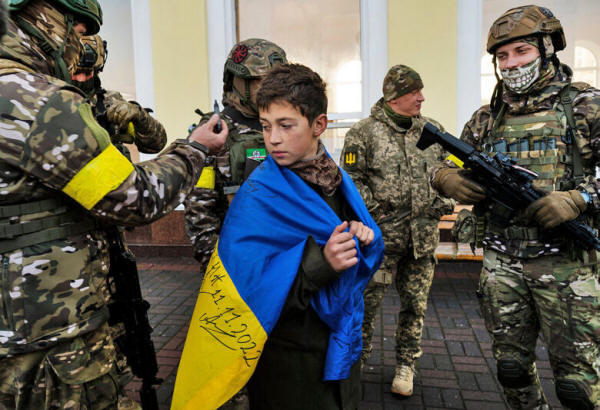
Ukrainians celebrated the
recapture of Kherson.
Lynsey Addario for The New York Times
The Ukrainians would still recapture Kherson and clear the Dnipro's
west bank. But the offensive halted there.
The Ukrainians, short on ammunition, would not
cross the Dnipro. They would not, as the Ukrainians had hoped and
the Russians feared, advance toward Crimea.
And as the Russians escaped across the river, farther into occupied
ground, huge machines rent the earth, cleaving long, deep trench
lines in their wake.
Still the Ukrainians were in a celebratory mood, and on his next
Wiesbaden trip, General Zabrodskyi presented General Donahue with a
"combat souvenir":
a tactical vest that had belonged to a
Russian soldier whose comrades were already marching east to
what would become the crucible of 2023 - a place called Bakhmut.
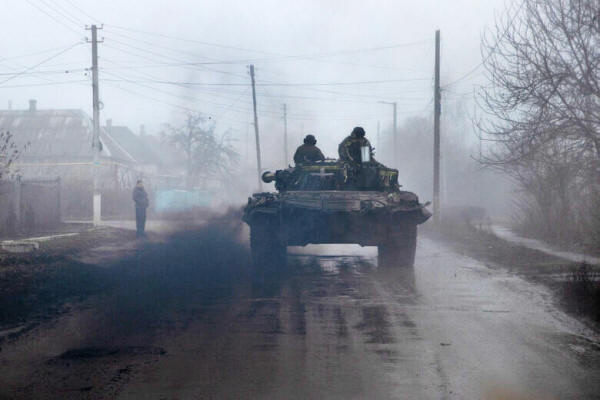
Ukrainian soldiers in Bakhmut,
a site of
prolonged combat that
President
Volodymyr Zelensky called the
"fortress of
our morale."
Tyler Hicks/The New York Times
Part 3
November 2022–November 2023
The Best-Laid Plans
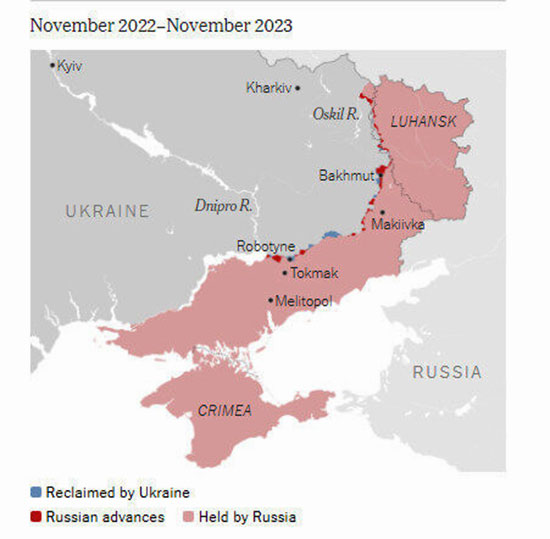
The planning for 2023 began straightaway, at what in hindsight was a
moment of irrational exuberance.
Ukraine controlled the west banks of the Oskil and Dnipro rivers.
Within the coalition, the prevailing wisdom was that the 2023
counteroffensive would be the war's last:
The Ukrainians would claim outright triumph, or
Mr. Putin would be forced to sue for peace.
"We're going to win this whole thing," Mr.
Zelensky told the coalition, a senior American official
recalled.
To accomplish this, General Zabrodskyi explained
as the partners gathered in Wiesbaden in late autumn, General
Zaluzhny was once again insisting that the primary effort be an
offensive toward Melitopol, to strangle Russian forces in Crimea -
what he believed had been the great, denied opportunity to deal the
reeling enemy a knockout blow in 2022.
And once again, some American generals were preaching caution.
At the Pentagon, officials worried about their ability to supply
enough weapons for the counteroffensive; perhaps the Ukrainians, in
their strongest possible position, should consider cutting a deal.
When the Joint Chiefs chairman, General Milley,
floated that idea in a speech, many of Ukraine's supporters
(including congressional Republicans, then overwhelmingly supportive
of the war) cried appeasement.
In Wiesbaden, in private conversations with General Zabrodskyi and
the British, General Donahue pointed to those Russian trenches being
dug to defend the south.
He pointed, too, to the Ukrainians' halting
advance to the Dnipro just weeks before.
"They're digging in, guys," he told them.
"How are you going to get across this?"
What he advocated instead, General Zabrodskyi and
a European official recalled, was a pause:
If the Ukrainians spent the next year, if not
longer, building and training new brigades, they would be far
better positioned to fight through to Melitopol.
The British, for their part, argued that
if the Ukrainians were going to go anyway, the coalition needed to
help them. They didn't have to be as good as the British and
Americans, General Cavoli would say; they just had to be better than
the Russians.
There would be no pause. General Zabrodskyi would tell General
Zaluzhny,
"Donahue is right."
But he would also admit that,
"nobody liked Donahue's recommendations,
except me."
And besides, General Donahue was a man on the way
out.
The 18th Airborne's deployment had always been temporary.
There would now be a more permanent organization in Wiesbaden, the
Security Assistance Group-Ukraine, call sign Erebus - the Greek
mythological personification of darkness.
That autumn day, the planning session and their time together done,
General Donahue escorted General Zabrodskyi to the Clay Kaserne
airfield. There he presented him with an ornamental shield - the 18th
Airborne dragon insignia, encircled by five stars.
The westernmost represented Wiesbaden; slightly to the east was the
Rzeszów-Jasionka Airport. The other stars represented Kyiv, Kherson
and Kharkiv - for General Zaluzhny and the commanders in the south
and east.
And beneath the stars, "Thanks."
"I asked him, 'Why are you thanking me?'"
General Zabrodskyi recalled.
"'I should say thank you.'"
General Donahue explained that the Ukrainians
were the ones fighting and dying, testing American equipment and
tactics and sharing lessons learned.
"Thanks to you," he said, "we built all these
things that we never could have."
Shouting through the airfield wind and noise,
they went back and forth about who deserved the most thanks. Then
they shook hands, and General Zabrodskyi disappeared into the idling
C-130.
The "new guy in the room" was Lt. Gen. Antonio A. Aguto Jr.
He was a different kind of commander, with a different kind of
mission.
General Donahue was a risk taker. General Aguto had built a
reputation as a man of deliberation and master of training and
large-scale operations.
After the seizure of Crimea in 2014, the Obama
administration had expanded its training of the Ukrainians,
including at a base in the far west of the country; General Aguto
had overseen the program.
In Wiesbaden, his No. 1 priority would be
preparing new brigades.
"You've got to get them ready for the fight,"
Mr. Austin, the defense secretary, told him.
That translated to greater autonomy for the
Ukrainians, a rebalancing of the relationship: At first, Wiesbaden
had labored to win the Ukrainians' trust. Now the Ukrainians were
asking for Wiesbaden's trust.
An opportunity soon presented itself.
Ukrainian intelligence had detected a makeshift Russian barracks at
a school in occupied Makiivka.
"Trust us on this," General Zabrodskyi told
General Aguto.
The American did, and the Ukrainian recalled,
"We did the full targeting process absolutely
independently.''
Wiesbaden's role would be limited to providing
coordinates.
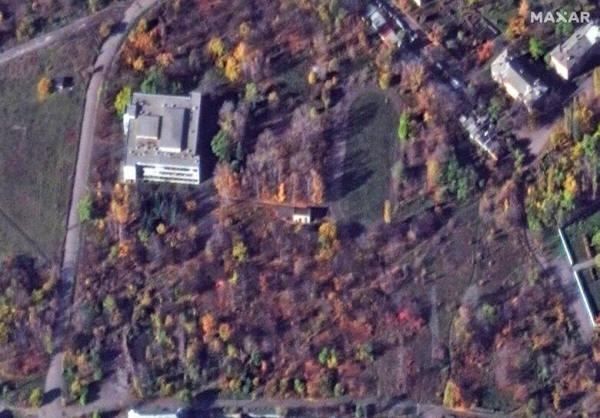
A satellite image of
a school in occupied Makiivka
where Russians had
established a barracks.
Maxar Technologies
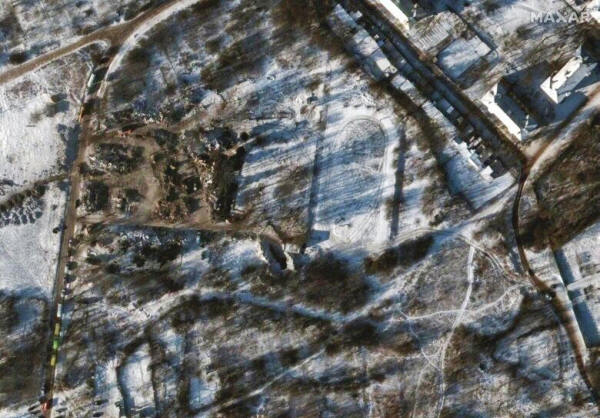
The site after a strike that was
aided by U.S. intelligence.
Maxar Technologies
In this new phase of the partnership, U.S. and Ukrainian officers
would still meet daily to set priorities, which the fusion center
turned into points of interest.
But Ukrainian commanders now had a freer hand to
use HIMARS to strike additional targets, fruit of their own
intelligence - if they furthered agreed-upon priorities.
"We will step back and watch, and keep an eye
on you to make sure that you don't do anything crazy," General
Aguto told the Ukrainians.
"The whole goal," he added, "is to have you
operate on your own at some point in time."
Echoing 2022, the war games of January 2023
yielded a two-pronged plan.
The secondary offensive, by General Syrsky's forces in the east,
would be focused on Bakhmut - where combat had been smoldering for
months - with a feint toward the Luhansk region, an area annexed by
Mr. Putin in 2022.
That maneuver, the thinking went, would tie up
Russian forces in the east and smooth the way for the main effort,
in the south - the attack on Melitopol, where Russian fortifications
were already rotting and collapsing in the winter wet and cold.
But problems of a different sort were already gnawing at the
new-made plan.
General Zaluzhny may have been Ukraine's supreme commander, but his
supremacy was increasingly compromised by his competition with
General Syrsky.
According to Ukrainian officials, the rivalry
dated to Mr. Zelensky's decision, in 2021, to elevate General
Zaluzhny over his former boss, General Syrsky.
The rivalry had intensified after the invasion,
as the commanders vied for limited HIMARS batteries. General Syrsky
had been born in Russia and served in its army; until he started
working on his Ukrainian, he had generally spoken Russian at
meetings.
General Zaluzhny sometimes derisively called him
"that Russian general."
The Americans knew General Syrsky was unhappy about being dealt a
supporting hand in the counteroffensive.
When General Aguto called to make sure he
understood the plan, he responded,
"I don't agree, but I have my orders."
The counteroffensive was to begin on May 1.
The intervening months would be spent training
for it. General Syrsky would contribute four battle-hardened
brigades - each between 3,000 and 5,000 soldiers - for training in
Europe; they would be joined by four brigades of new recruits.
The general had other plans.
In Bakhmut, the Russians were deploying, and losing, vast numbers of
soldiers. General Syrsky saw an opportunity to engulf them and
ignite discord in their ranks.
"Take all new guys" for Melitopol, he told
General Aguto, according to U.S. officials.
And when Mr. Zelensky sided with him, over the
objections of both his own supreme commander and the Americans, a
key underpinning of the counteroffensive was effectively scuttled.
Now the Ukrainians would send just four untested brigades abroad for
training. (They would prepare eight more inside Ukraine.) Plus, the
new recruits were old - mostly in their 40s and 50s.
When they arrived in Europe, a senior U.S.
official recalled,
"All we kept thinking was, This is not
great."
The Ukrainian draft age was 27.
General Cavoli, who had been promoted to supreme
allied commander for Europe, implored General Zaluzhny to,
"get your 18-year-olds in the game."
But the Americans concluded that neither the
president nor the general would own such a politically fraught
decision.
A parallel dynamic was at play on the American side.
The previous year, the Russians had unwisely placed command posts,
ammunition depots and logistics centers within 50 miles of the front
lines. But new intelligence showed that the Russians had now moved
critical installations beyond HIMARS' reach.
So Generals Cavoli and Aguto recommended the next
quantum leap, giving the Ukrainians Army Tactical Missile Systems -
missiles, known as ATACMS, that can travel up to 190 miles - to make
it harder for Russian forces in Crimea to help defend Melitopol.
ATACMS were a particularly sore subject for the Biden
administration. Russia's military chief, General Gerasimov, had
indirectly referred to them the previous May when he warned General
Milley that anything that flew 190 miles would be breaching a red
line.
There was also a question of supply:
The Pentagon was already warning that it
would not have enough ATACMS if America had to fight its own
war.
The message was blunt: Stop asking for ATACMS.
Underlying assumptions had been upended. Still, the Americans saw a
path to victory, albeit a narrowing one. Key to threading that
needle was beginning the counteroffensive on schedule, on May 1,
before the Russians repaired their fortifications and moved more
troops to reinforce Melitopol.
But the drop-dead date came and went. Some promised deliveries of
ammunition and equipment had been delayed, and despite General
Aguto's assurances that there was enough to start, the Ukrainians
wouldn't commit until they had it all.
At one point, frustration rising, General Cavoli turned to General
Zabrodskyi and said:
"Misha, I love your country. But if you don't
do this, you're going to lose the war."
"My answer was: 'I understand what you are saying, Christopher.
But please understand me. I'm not the supreme commander. And I'm
not the president of Ukraine'," General Zabrodskyi recalled,
adding, "Probably I needed to cry as much as he did."
At the Pentagon, officials were beginning to
sense some graver fissure opening. General Zabrodskyi recalled
General Milley asking:
"Tell me the truth. Did you change the plan?"
"No, no, no," he responded.
"We did not change the plan, and we are not
going to."
When he uttered these words, he genuinely
believed he was telling the truth.
In late May, intelligence showed the Russians rapidly building new
brigades. The Ukrainians didn't have everything they wanted, but
they had what they thought they needed. They would have to go.
General Zaluzhny outlined the final plan at a meeting of the Stavka,
a governmental body overseeing military matters. General Tarnavskyi
would have 12 brigades and the bulk of ammunition for the main
assault, on Melitopol.
The marine commandant, Lt. Gen. Yurii Sodol,
would feint toward Mariupol, the ruined port city taken by the
Russians after a withering siege the year before. General Syrsky
would lead the supporting effort in the east around Bakhmut,
recently lost after months of trench warfare.
Then General Syrsky spoke.
According to Ukrainian officials, the general
said he wanted to break from the plan and execute a full-scale
attack to drive the Russians from Bakhmut. He would then advance
eastward toward the Luhansk region. He would, of course, need
additional men and ammunition.
The Americans were not told the meeting's outcome. But then U.S.
intelligence observed Ukrainian troops and ammunition moving in
directions inconsistent with the agreed-upon plan.
Soon after, at a hastily arranged meeting on the Polish border,
General Zaluzhny admitted to Generals Cavoli and Aguto that the
Ukrainians had in fact decided to mount assaults in three directions
at once.
"That's not the plan!" General Cavoli cried.
What had happened, according to Ukrainian
officials, was this:
After the Stavka meeting, Mr. Zelensky had
ordered that the coalition's ammunition be split evenly between
General Syrsky and General Tarnavskyi.
General Syrsky would also get five of the newly
trained brigades, leaving seven for the Melitopol fight.
"It was like watching the demise of the
Melitopol offensive even before it was launched," one Ukrainian
official remarked.
Fifteen months into the war, it had all come to
this tipping point.
"We should have walked away," said a senior
American official.
But they would not.
"These decisions involving life and death,
and what territory you value more and what territory you value
less, are fundamentally sovereign decisions," a senior Biden
administration official explained.
"All we could do was give them advice."
The leader of the Mariupol assault, General
Sodol, was an eager consumer of General Aguto's advice.
That collaboration produced one of the
counteroffensive's biggest successes: After American intelligence
identified a weak point in Russian lines, General Sodol's forces,
using Wiesbaden's points of interest, recaptured the village of
Staromaiorske and nearly eight square miles of territory.
For the Ukrainians, that victory posed a question: Might the
Mariupol fight be more promising than the one toward Melitopol? But
the attack stalled for lack of manpower.
The problem was laid out right there on the battlefield map in
General Aguto's office:
General Syrsky's assault on Bakhmut was
starving the Ukrainian army.
General Aguto urged him to send brigades and
ammunition south for the Melitopol attack.
But General Syrsky wouldn't budge, according to
U.S. and Ukrainian officials. Nor would he budge when Yevgeny
Prigozhin, whose Wagner paramilitaries had helped the Russians
capture Bakhmut, rebelled against Mr. Putin's military leadership
and sent forces racing toward Moscow.
U.S. intelligence assessed that the rebellion could erode Russian
morale and cohesion; intercepts detected Russian commanders
surprised that the Ukrainians weren't pushing harder toward
tenuously defended Melitopol, a U.S. intelligence official said.
But as General Syrsky saw it, the rebellion validated his strategy
of sowing division by impaling the Russians in Bakhmut. To send some
of his forces south would only undercut it.
"I was right, Aguto. You were wrong," an
American official recalls General Syrsky saying and adding,
"We're going to get to Luhansk."
Mr. Zelensky had framed Bakhmut as the
"fortress of our morale."
In the end, it was a blood-drenched demonstration
of the outmanned Ukrainians' predicament.
Though counts vary wildly, there is little question that the
Russians' casualties - in the tens of thousands - far outstripped
the Ukrainians'. Yet General Syrsky never did recapture Bakhmut,
never did advance toward Luhansk.
And while the Russians rebuilt their brigades and
soldiered on in the east, the Ukrainians had no such easy source of
recruits.
(Mr. Prigozhin pulled his rebels back before
reaching Moscow; two months later, he died in a plane crash that
American intelligence believed had the hallmarks of a
Kremlin-sponsored assassination.)
Which left Melitopol...
A primary virtue of the Wiesbaden machine was speed - shrinking the
time from point of interest to Ukrainian strike. But that virtue,
and with it the Melitopol offensive, was undermined by a fundamental
shift in how the Ukrainian commander there used those points of
interest.
He had substantially less ammunition than he had
planned for; instead of simply firing, he would now first use drones
to confirm the intelligence.
This corrosive pattern, fueled, too, by caution and a deficit of
trust, came to a head when, after weeks of grindingly slow progress
across a hellscape of minefields and helicopter fire, Ukrainian
forces approached the occupied village of Robotyne.
American officials recounted the ensuing battle.
The Ukrainians had been pummeling the Russians
with artillery; American intelligence indicated they were pulling
back.
"Take the ground now," General Aguto told
General Tarnavskyi.
But the Ukrainians had spotted a group of
Russians on a hilltop.
In Wiesbaden, satellite imagery showed what looked like a Russian
platoon, between 20 and 50 soldiers - to General Aguto hardly
justification to slow the march.
General Tarnavskyi, though, wouldn't move until the threat was
eliminated. So Wiesbaden sent the Russians' coordinates and advised
him to simultaneously open fire and advance.
Instead, to verify the intelligence, General Tarnavskyi flew
reconnaissance drones over the hilltop.
Which took time. Only then did he order his men to fire.
And after the strike, he once again dispatched his drones, to
confirm the hilltop was indeed clear. Then he ordered his forces
into Robotyne, which they seized on Aug. 28.
The back-and-forth had cost between 24 and 48 hours, officers
estimated.
And in that time, south of Robotyne, the Russians
had begun building new barriers, laying mines and sending
reinforcements to halt Ukrainian progress.
"The situation was changed completely,"
General Zabrodskyi said.
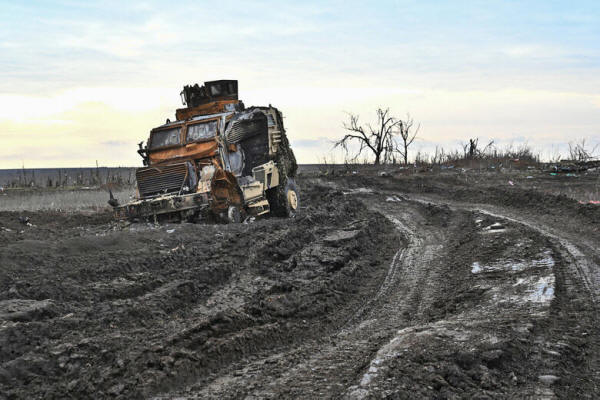
An abandoned Ukrainian military
vehicle
near the
front line of Robotyne.
Reuters
General Aguto yelled at General Tarnavskyi:
Press on...
But the Ukrainians had to rotate troops from the
front lines to the rear, and with only the seven brigades, they
weren't able to bring in new forces fast enough to keep going.
The Ukrainian advance, in fact, was slowed by a mix of factors.
But in Wiesbaden, the frustrated Americans kept
talking about the platoon on the hill.
"A damned platoon stopped the
counteroffensive," one officer remarked.
The Ukrainians would not make it to Melitopol.
They would have to scale back their ambitions.
Now their objective would be the small occupied city of Tokmak,
about halfway to Melitopol, close to critical rail lines and
roadways.
General Aguto had given the Ukrainians greater autonomy. But now he
crafted a detailed artillery plan, Operation Rolling Thunder, that
prescribed what the Ukrainians should shoot, with what and in what
order, according to U.S. and Ukrainian officials.
But General Tarnavskyi objected to some targets,
insisted on using drones to verify points of interest and Rolling
Thunder rumbled to a halt.
Desperate to salvage the counteroffensive, the White House had
authorized a secret transport of a small number of cluster warheads
with a range of about 100 miles, and General Aguto and
General Zabrodskyi devised an operation against Russian
attack helicopters threatening General Tarnavskyi's forces.
At least 10 helicopters were destroyed, and the
Russians pulled all their aircraft back to Crimea or the mainland.
Still, the Ukrainians couldn't advance.
The Americans' last-ditch recommendation was to have General Syrsky
take over the Tokmak fight.
That was rejected.
They then proposed that General Sodol send
his marines to Robotyne and have them break through the Russian
line.
But instead General Zaluzhny ordered the
marines to Kherson to open a new front in an operation the Americans
counseled was doomed to fail - trying to cross the Dnipro and
advance toward Crimea.
The marines made it across the river in early
November but ran out of men and ammunition. The counteroffensive was
supposed to deliver a knockout blow. Instead, it met an inglorious
end.
General Syrsky declined to answer questions about his
interactions with American generals, but a spokesman for the
Ukrainian armed forces said,
"We do hope that the time will come, and
after the victory of Ukraine, the Ukrainian and American
generals you mentioned will perhaps jointly tell us about their
working and friendly negotiations during the fighting against
Russian aggression."
Andriy Yermak, head of the presidential
office of Ukraine and arguably the country's second-most-powerful
official, told The Times that the counteroffensive had ,
"primarily blunted" by the allies'
"political hesitation" and "constant" delays in weapons
deliveries.
But to another senior Ukrainian official,
"The real reason why we were not successful
was because an improper number of forces were assigned to
execute the plan."
Either way, for the partners, the
counteroffensive's devastating outcome left bruised feelings on both
sides.
"The important relationships were
maintained," said Ms. Wallander, the Pentagon official.
"But it was no longer the inspired and
trusting brotherhood of 2022 and early 2023."
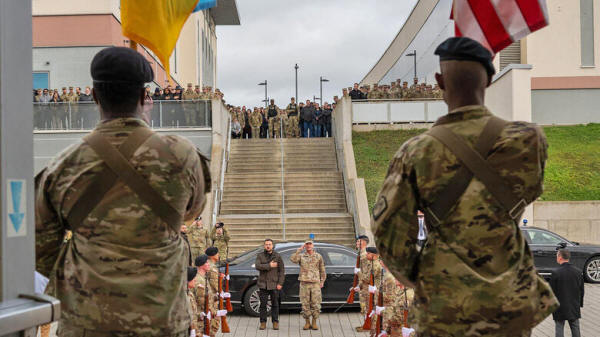
President Volodymyr Zelensky
and Gen.
Christopher G. Cavoli
in Wiesbaden in
December 2023.
Susanne Goebel/U.S. European Command
Part 4
December 2023–January 2025
Breaches of Trust, and of Borders
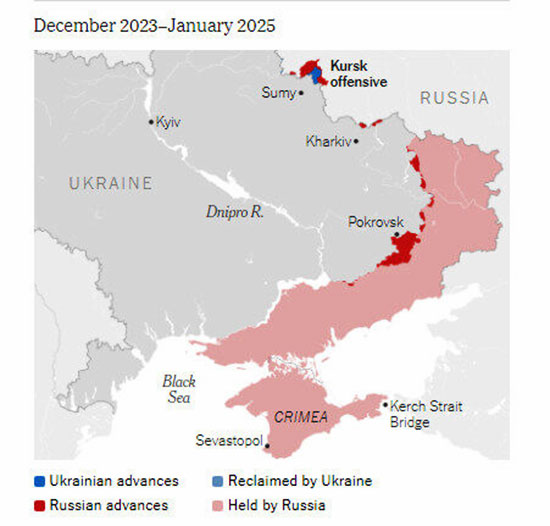
Shortly before Christmas, Mr. Zelensky rode through the Wiesbaden
gates for his maiden visit to the secret center of the partnership.
Entering the Tony Bass Auditorium, he was escorted past trophies of
shared battle - twisted fragments of Russian vehicles, missiles and
aircraft. When he climbed to the walkway above the former basketball
court - as General Zabrodskyi had done that first day in 2022 - the
officers working below burst into applause.
Yet the president had not come to Wiesbaden for celebration.
In the shadow of the failed counteroffensive, a
third, hard wartime winter coming on, the portents had only
darkened. To press their new advantage, the Russians were pouring
forces into the east.
In America, Mr. Trump, a Ukraine skeptic,
was mid-political resurrection; some congressional Republicans were
grumbling about cutting off funding.
A year ago, the coalition had been talking victory. As 2024 arrived
and ground on, the Biden administration would find itself forced to
keep crossing its own red lines simply to keep the Ukrainians
afloat.
But first, the immediate business in Wiesbaden: Generals Cavoli and
Aguto explained that they saw no plausible path to reclaiming
significant territory in 2024. The coalition simply couldn't provide
all the equipment for a major counteroffensive.
Nor could the Ukrainians build an army big enough
to mount one.
The Ukrainians would have to temper expectations, focusing on
achievable objectives to stay in the fight while building the combat
power to potentially mount a counteroffensive in 2025:
They would need to erect defensive lines in
the east to prevent the Russians from seizing more territory.
And they would need to reconstitute existing
brigades and fill new ones, which the coalition would help train
and equip.
Mr. Zelensky voiced his support.
Yet the Americans knew he did so grudgingly. Time and again Mr.
Zelensky had made it clear that he wanted, and needed, a big win to
bolster morale at home and shore up Western support.
Just weeks before, the president had instructed General Zaluzhny to
push the Russians back to Ukraine's 1991 borders by fall of 2024.
The general had then shocked the Americans by presenting a plan to
do so that required five million shells and one million drones.
To which General Cavoli had responded, in fluent
Russian,
"From where?"
Several weeks later, at a meeting in Kyiv, the
Ukrainian commander had locked General Cavoli in a Defense Ministry
kitchen and, vaping furiously, made one final, futile plea.
"He was caught between two fires, the first
being the president and the second being the partners," said one
of his aides.
As a compromise, the Americans now presented Mr.
Zelensky with what they believed would constitute a statement
victory - a bombing campaign, using long-range missiles and drones,
to force the Russians to pull their military infrastructure out of
Crimea and back into Russia.
It would be code-named Operation Lunar Hail.
Until now, the Ukrainians, with help from the CIA and the U.S. and
British navies, had used maritime drones, together with long-range
British Storm Shadow and French SCALP missiles, to strike the Black
Sea Fleet. Wiesbaden's contribution was intelligence.
But to prosecute the wider Crimea campaign, the Ukrainians would
need far more missiles. They would need hundreds of ATACMS.
At the Pentagon, the old cautions hadn't melted away. But after
General Aguto briefed Mr. Austin on all that Lunar Hail could
achieve, an aide recalled, he said:
"OK, there's a really compelling strategic
objective here. It isn't just about striking things."
Mr. Zelensky would get his long-pined-for ATACMS.
Even so, one U.S. official said,
"We knew that, in his heart of hearts, he
still wanted to do something else, something more."
General Zabrodskyi was in the Wiesbaden command
center in late January when he received an urgent message and
stepped outside.
When he returned, gone pale as a ghost, he led General Aguto to a
balcony and, pulling on a Lucky Strike, told him that the Ukrainian
leadership struggle had reached its denouement: General Zaluzhny was
being fired.
The betting was on his rival, General Syrsky, to
ascend.
The Americans were hardly surprised; they had been hearing ample
murmurings of presidential discontent. The Ukrainians would chalk it
up to politics, to fear that the widely popular General Zaluzhny
might challenge Mr. Zelensky for the presidency.
There was also the Stavka meeting, where the
president effectively kneecapped General Zaluzhny, and the general's
subsequent decision to publish a piece in The Economist declaring
the war at a stalemate, the Ukrainians in need of a quantum
technological breakthrough.
This even as his president was calling for total
victory.
General Zaluzhny, one American official said, was ,
"dead man walking."
General Syrsky's appointment brought hedged
relief.
The Americans believed they would now have
a partner with the president's ear and trust; decision-making, they
hoped, would become more consistent.
General Syrsky was also a known commodity.
Part of that knowledge, of course, was the memory of 2023, the scar
of Bakhmut - the way the general had sometimes spurned their
recommendations, even sought to undermine them.
Still, colleagues say, Generals Cavoli and Aguto
felt they understood his idiosyncrasies; he would at least hear them
out, and unlike some commanders, he appreciated and typically
trusted the intelligence they provided.
For General Zabrodskyi, though, the shake-up was a personal blow and
a strategic unknown. He considered General Zaluzhny a friend and had
given up his parliamentary seat to become his deputy for plans and
operations.
(Soon he would be pushed out of that job, and his
Wiesbaden role. When General Aguto found out, he called with a
standing invitation to his North Carolina beach house; the generals
could go sailing. "Maybe in my next life," General Zabrodskyi
replied.)
And the changing of the guard came at a particularly uncertain
moment for the partnership: Goaded by Mr. Trump, congressional
Republicans were holding up $61 billion in new military aid.
During the battle for Melitopol, the commander
had insisted on using drones to validate every point of interest.
Now, with far fewer rockets and shells,
commanders along the front adopted the same protocol. Wiesbaden was
still churning out points of interest, but the Ukrainians were
barely using them.
"We don't need this right now," General
Zabrodskyi told the Americans.
The red lines kept moving...
There were the ATACMS, which arrived secretly in early spring, so
the Russians wouldn't realize Ukraine could now strike across
Crimea.
And there were the SMEs. Some months earlier, General Aguto had been
allowed to send a small team, about a dozen officers, to Kyiv,
easing the prohibition on American boots on Ukrainian ground. So as
not to evoke memories of the American military advisers sent to
South Vietnam in the slide to full-scale war, they would be known as
"subject matter experts."
Then, after the Ukrainian leadership shake-up, to
build confidence and coordination, the administration more than
tripled the number of officers in Kyiv, to about three dozen; they
could now plainly be called advisers, though they would still be
confined to the Kyiv area.
Perhaps the hardest red line, though, was the Russian border. Soon
that line, too, would be redrawn.
In April, the financing logjam was finally cleared, and 180 more
ATACMS, dozens of armored vehicles and 85,000 155-millimeter shells
started flowing in from Poland.
Coalition intelligence, though, was detecting another sort of
movement:
Components of a new Russian formation, the 44th
Army Corps, moving toward Belgorod, just north of the Ukrainian
border.
The Russians, seeing a limited window as the
Ukrainians waited to have the American aid in hand, were preparing
to open a new front in northern Ukraine.
The Ukrainians believed the Russians hoped to reach a major road
ringing Kharkiv, which would allow them to bombard the city, the
country's second-largest, with artillery fire, and threaten the
lives of more than a million people.
The Russian offensive exposed a fundamental asymmetry: The Russians
could support their troops with artillery from just across the
border; the Ukrainians couldn't shoot back using American equipment
or intelligence.
Yet with peril came opportunity. The Russians were complacent about
security, believing the Americans would never let the Ukrainians
fire into Russia. Entire units and their equipment were sitting
unsheltered, largely undefended, in open fields.
The Ukrainians asked for permission to use U.S.-supplied weapons
across the border.
What's more, Generals Cavoli and Aguto proposed
that Wiesbaden help guide those strikes, as it did across Ukraine
and in Crimea - providing points of interest and precision
coordinates.
The White House was still debating these questions when, on May 10,
the Russians attacked.
This became the moment the Biden administration changed the rules of
the game. Generals Cavoli and Aguto were tasked with creating an
"ops box" - a zone on Russian soil in which the Ukrainians could
fire U.S.-supplied weapons and Wiesbaden could support their
strikes.
At first they advocated an expansive box, to encompass a concomitant
threat: the glide bombs - crude Soviet-era bombs transformed into
precision weapons with wings and fins - that were raining terror on
Kharkiv.
A box extending about 190 miles would let the
Ukrainians use their new ATACMS to hit glide-bomb fields and other
targets deep inside Russia.
But Mr. Austin saw this as mission creep:
He did not want to divert ATACMS from Lunar
Hail.
Instead, the generals were instructed to draw up
two options:
one extending about 50 miles into Russia,
standard HIMARS range, and one nearly twice as deep.
Ultimately, against the generals' recommendation,
Mr. Biden and his advisers chose the most limited option - but to
protect the city of Sumy as well as Kharkiv, it followed most of the
country's northern border, encompassing an area almost as large as
New Jersey.
The CIA was also authorized to send officers to
the Kharkiv region to assist their Ukrainian counterparts with
operations inside the box.
The box went live at the end of May. The Russians were caught
unawares: With Wiesbaden's points of interest and coordinates, as
well as the Ukrainians' own intelligence, HIMARS strikes into the
ops box helped defend Kharkiv.
The Russians suffered some of their heaviest
casualties of the war.
The unthinkable had become real. The United States was now woven
into the killing of Russian soldiers on sovereign Russian soil.
Summer 2024:
Ukraine's armies in the north and east were
stretched dangerously thin. Still, General Syrsky kept telling
the Americans, "I need a win."
A foreshadowing had come back in March, when the
Americans discovered that Ukraine's military intelligence agency,
the HUR, was furtively planning a ground operation into southwest
Russia.
The CIA station chief in Kyiv confronted the HUR
commander, Gen. Kyrylo Budanov:
If he crossed into Russia, he would do so
without American weapons or intelligence support. He did, only
to be forced back.
At moments like these, Biden administration
officials would joke bitterly that they knew more about what the
Russians were planning by spying on them than about what their
Ukrainian partners were planning.
To the Ukrainians, though, "don't ask, don't tell," was "better than
ask and stop," explained Lt. Gen. Valeriy Kondratiuk, a
former Ukrainian military intelligence commander.
He added:
"We are allies, but we have different goals.
We protect our country, and you protect your phantom fears from
the Cold War."
In August in Wiesbaden, General Aguto's tour was
coming to its scheduled end. He left on the 9th. The same
day, the Ukrainians dropped a cryptic reference to something
happening in the north.
On Aug. 10, the CIA station chief left, too, for a job at
headquarters. In the churn of command, General Syrsky made his move
- sending troops across the southwest Russian border, into the
region of Kursk.
For the Americans, the incursion's unfolding was a significant
breach of trust. It wasn't just that the Ukrainians had again kept
them in the dark; they had secretly crossed a mutually agreed-upon
line, taking coalition-supplied equipment into Russian territory
encompassed by the ops box, in violation of rules laid down when it
was created.
The box had been established to prevent a humanitarian disaster in
Kharkiv, not so the Ukrainians could take advantage of it to seize
Russian soil.
"It wasn't almost blackmail, it was
blackmail," a senior Pentagon official said.
The Americans could have pulled the plug on the
ops box. Yet they knew that to do so, an administration official
explained,
"could lead to a catastrophe":
Ukrainian soldiers in Kursk would perish
unprotected by HIMARS rockets and U.S. intelligence.
Kursk, the Americans concluded, was the win Mr.
Zelensky had been hinting at all along.
It was also evidence of his calculations:
He still spoke of total victory.
But one of the operation's goals, he explained to
the Americans, was leverage - to capture and hold Russian land that
could be traded for Ukrainian land in future negotiations.
Provocative operations once forbidden were now permitted.
Before General Zabrodskyi was sidelined, he and General Aguto had
selected the targets for Operation Lunar Hail. The campaign required
a degree of hand-holding not seen since General Donahue's day.
American and British officers would oversee
virtually every aspect of each strike, from determining the
coordinates to calculating the missiles' flight paths.
Of roughly 100 targets across Crimea, the most coveted was the Kerch
Strait Bridge, linking the peninsula to the Russian mainland. Mr.
Putin saw the bridge as powerful physical proof of Crimea's
connection to the motherland. Toppling the Russian president's
symbol had, in turn, become the Ukrainian president's obsession.
It had also been an American red line. In 2022, the Biden
administration prohibited helping the Ukrainians target it; even the
approaches on the Crimean side were to be treated as sovereign
Russian territory. (Ukrainian intelligence services tried attacking
it themselves, causing some damage.)
But after the partners agreed on Lunar Hail, the White House
authorized the military and CIA to secretly work with the Ukrainians
and the British on a blueprint of attack to bring the bridge down:
ATACMS would weaken vulnerable points on the
deck, while maritime drones would blow up next to its
stanchions.
But while the drones were being readied, the
Russians hardened their defenses around the stanchions.
The Ukrainians proposed attacking with ATACMS alone. Generals Cavoli
and Aguto pushed back: ATACMS alone wouldn't do the job; the
Ukrainians should wait until the drones were ready or call off the
strike.
In the end, the Americans stood down, and in mid-August, with
Wiesbaden's reluctant help, the Ukrainians fired a volley of ATACMS
at the bridge.
It did not come tumbling down; the strike left
some "potholes," which the Russians repaired, one American official
grumbled, adding,
"Sometimes they need to try and fail to see
that we are right."
The Kerch Bridge episode aside, the
Lunar Hail collaboration was judged a significant success.
Russian warships, aircraft, command posts,
weapons depots and maintenance facilities were destroyed or moved to
the mainland to escape the onslaught.
For the Biden administration, the failed Kerch attack, together with
a scarcity of ATACMS, reinforced the importance of helping the
Ukrainians use their fleet of long-distance attack drones.
The main challenge was evading Russian air
defenses and pinpointing targets.
Longstanding policy barred the CIA from providing intelligence on
targets on Russian soil. So the administration would let the CIA
request "variances," carve-outs authorizing the spy agency to
support strikes inside Russia to achieve specific objectives.
Intelligence had identified a vast munitions depot in the lakeside
town of Toropets, some 290 miles north of the Ukrainian border, that
was providing weapons to Russian forces in Kharkiv and Kursk.
The administration approved the variance.
Toropets would be a test of concept.
CIA officers shared intelligence about the depot's munitions and
vulnerabilities, as well as Russian defense systems on the way to
Toropets. They calculated how many drones the operation would
require and charted their circuitous flight paths.
On Sept. 18, a large swarm of drones slammed into the munitions
depot.
The blast, as powerful as a small earthquake,
opened a crater the width of a football field. Videos showed immense
balls of flame and plumes of smoke rising above the lake.
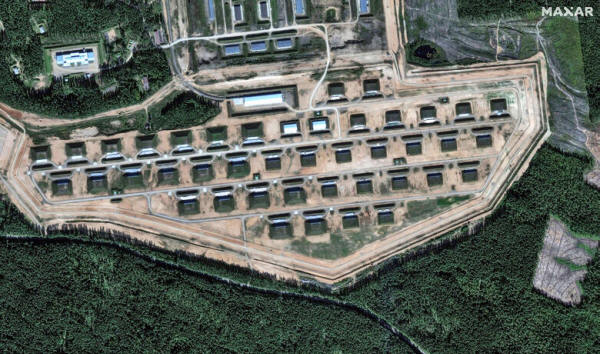
A munitions depot
in Toropets,
Russia.
Maxar Technologies
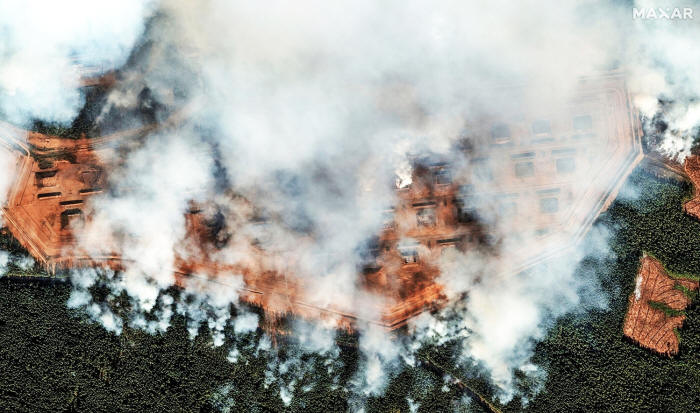
The depot after a drone strike
assisted by the
CIA.
Maxar Technologies
Yet as with the Kerch Bridge operation, the drone collaboration
pointed to a strategic dissonance.
The Americans argued for concentrating drone strikes on
strategically important military targets - the same sort of argument
they had made, fruitlessly, about focusing on Melitopol during the
2023 counteroffensive.
But the Ukrainians insisted on attacking a wider
menu of targets, including oil and gas facilities and politically
sensitive sites in and around Moscow (though they would do so
without CIA help).
"Russian public opinion is going to turn on
Putin," Mr. Zelensky told the American secretary of
state, Antony Blinken, in Kyiv in September.
"You're wrong. We know the Russians."
Mr. Austin and General Cavoli traveled to Kyiv in
October.
Year by year, the Biden administration had
provided the Ukrainians with an ever-more-sophisticated arsenal of
weaponry, had crossed so many of its red lines. Still, the defense
secretary and the general were worrying about the message written in
the weakening situation on the ground.
The Russians had been making slow but steady progress against
depleted Ukrainian forces in the east, toward the city of Pokrovsk -
their "big target," one American official called it. They were also
clawing back some territory in Kursk.
Yes, the Russians' casualties had spiked, to
between 1,000 and 1,500 a day. But still they kept coming.
Mr. Austin would later recount how he contemplated this manpower
mismatch as he looked out the window of his armored S.U.V. snaking
through the Kyiv streets. He was struck, he told aides, by the sight
of so many men in their 20s, almost none of them in uniform. In a
nation at war, he explained, men this age are usually away, in the
fight.
This was one of the difficult messages the Americans had come to
Kyiv to deliver, as they laid out what they could and couldn't do
for Ukraine in 2025.
Mr. Zelensky had already taken a small step, lowering the draft age
to 25. Still, the Ukrainians hadn't been able to fill existing
brigades, let alone build new ones.
Mr. Austin pressed Mr. Zelensky to take the bigger, bolder step and
begin drafting 18-year-olds. To which Mr. Zelensky shot back,
according to an official who was present,
"Why would I draft more people? We don't have
any equipment to give them."
"And your generals are reporting that your units are
undermanned," the official recalled Mr. Austin responding.
"They don't have enough soldiers for the
equipment they have."
That was the perennial standoff:
In the Ukrainians' view, the Americans
weren't willing to do what was necessary to help them prevail.
In the Americans' view, the Ukrainians weren't willing to do
what was necessary to help themselves prevail.
Mr. Zelensky often said, in response to the draft
question, that his country was fighting for its future, that 18- to
25-year-olds were the fathers of that future.
To one American official, though, it's,
"not an existential war if they won't make
their people fight."
General Baldwin, who early on had crucially
helped connect the partners' commanders, had visited Kyiv in
September 2023.
The counteroffensive was stalling, the U.S.
elections were on the horizon and the Ukrainians kept asking about
Afghanistan. The Ukrainians, he recalled, were terrified that they,
too, would be abandoned.
They kept calling, wanting to know if America
would stay the course, asking:
"What will happen if the Republicans win the
Congress? What is going to happen if President Trump wins?'"
He always told them to remain encouraged, he
said.
Still, he added,
"I had my fingers crossed behind my back,
because I really didn't know anymore."
Mr.
Trump won,
and the fear came rushing in.
In his last, lame-duck weeks, Mr. Biden made a flurry of moves to
stay the course, at least for the moment, and shore up his Ukraine
project.
He crossed his final red line - expanding the ops box to allow
ATACMS and British Storm Shadow strikes into Russia - after North
Korea sent thousands of troops to help the Russians dislodge the
Ukrainians from Kursk.
One of the first U.S.-supported strikes targeted
and wounded the North Korean commander, Col. Gen. Kim Yong Bok,
as he met with his Russian counterparts in a command bunker.
The administration also authorized Wiesbaden and the CIA to support
long-range missile and drone strikes into a section of southern
Russia used as a staging area for the assault on Pokrovsk, and
allowed the military advisers to leave Kyiv for command posts closer
to the fighting.
In December, General Donahue got his fourth star and returned
to Wiesbaden as commander of U.S. Army Europe and Africa. He had
been the last American soldier to leave in the chaotic fall of
Kabul.
Now he would have to navigate the new, unsure
future of Ukraine.
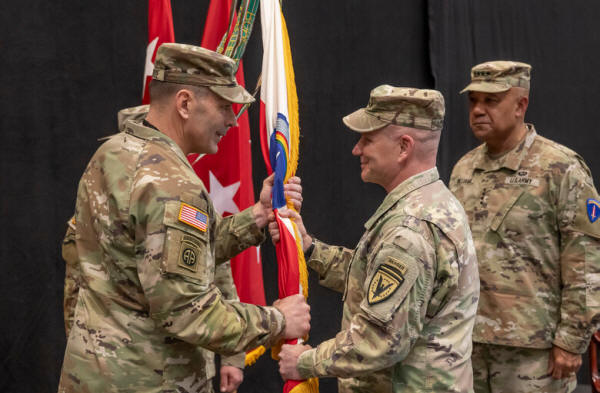
General Cavoli, center,
passed the
colors to General Donahue
in a ceremonial
change of command in Wiesbaden.
Volker Ramspott/U.S. Army
So much had changed since General Donahue left two years before.
But when it came to the raw question of
territory, not much had changed. In the war's first year, with
Wiesbaden's help, the Ukrainians had seized the upper hand, winning
back more than half of the land lost after the 2022 invasion. Now,
they were fighting over tiny slivers of ground in the east (and in
Kursk).
One of General Donahue's main objectives in Wiesbaden, according to
a Pentagon official, would be to fortify the brotherhood and breathe
new life into the machine - to stem, perhaps even push back, the
Russian advance.
(In the weeks that followed, with Wiesbaden
providing points of interest and coordinates, the Russian march
toward Pokrovsk would slow, and in some areas in the east, the
Ukrainians would make gains. But in southwest Russia, as the Trump
administration scaled back support, the Ukrainians would lose most
of their bargaining chip, Kursk.)
In early January, Generals Donahue and Cavoli visited Kyiv to meet
with General Syrsky and ensure that he agreed on plans to replenish
Ukrainian brigades and shore up their lines, the Pentagon official
said.
From there, they traveled to Ramstein Air Base,
where they met Mr. Austin for what would be the final gathering of
coalition defense chiefs before everything changed.
With the doors closed to the press and public, Mr. Austin's
counterparts hailed him as the "godfather" and "architect" of the
partnership that, for all its broken trust and betrayals, had
sustained the Ukrainians' defiance and hope, begun in earnest on
that spring day in 2022 when Generals Donahue and
Zabrodskyi first met in Wiesbaden.
Mr. Austin is a solid and stoic block of a man, but as he
returned the compliments, his voice caught.
"Instead of saying farewell, let me say thank
you," he said, blinking back tears.
And then added:
"I wish you all success, courage and resolve.
Ladies and gentlemen, carry on."
Sources and methodology
For each war map, we used data from the Institute for the Study of
War and the American Enterprise Institute's Critical Threats Project
to calculate changes in territorial control.
Russian forces in eastern Ukraine include
Russian-backed separatists.
The composite image in the introduction draws on
data from NASA's Moderate Resolution Imaging Spectroradiometer
(MODIS) and was compiled using Google Earth Engine.
We combined images from January and February of
each year since 2020 to generate a cloud-free satellite image.
|






















